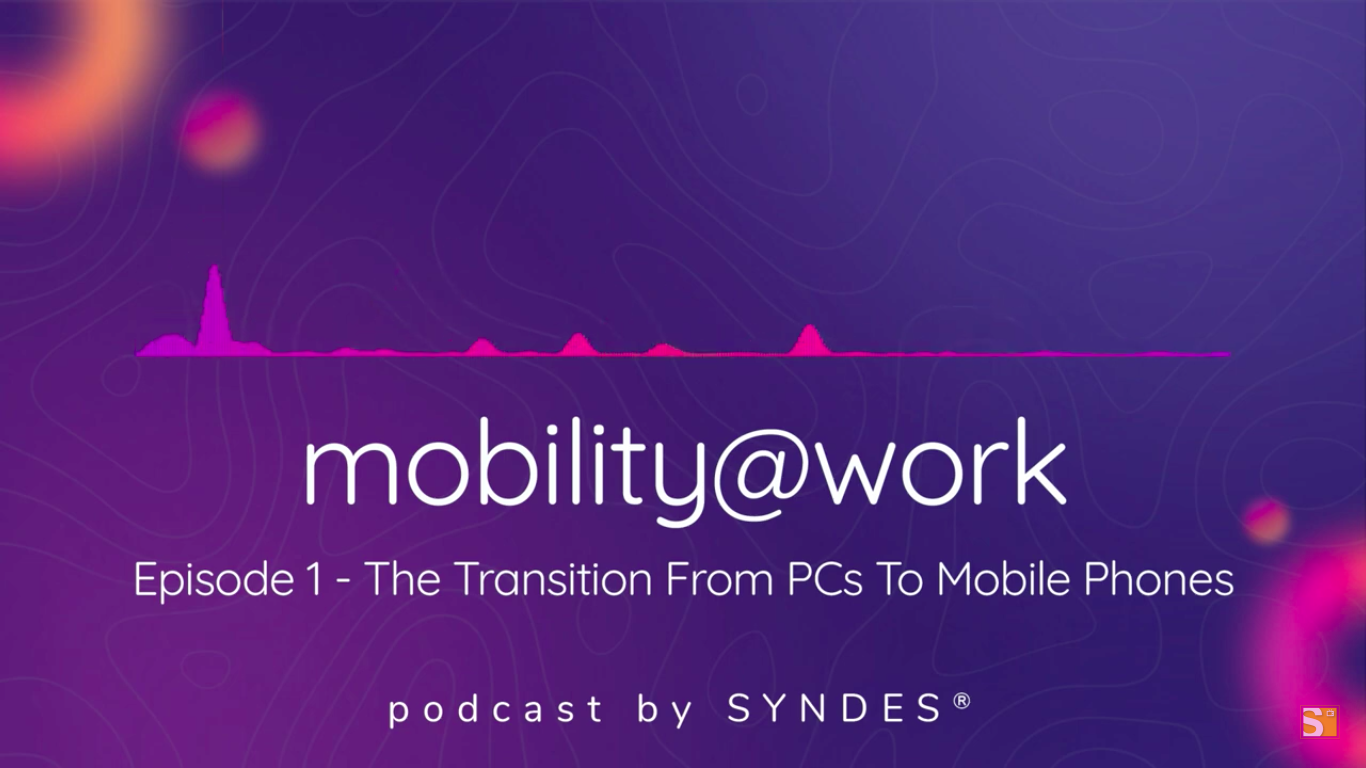
“The Transition From PCs To Mobile Devices” Mobility@Work Podcast
[Intro Music: “Tech House vibes” by Alejandro Magaña (A. M.)] TUN XIANG: Welcome to Mobility@Work and my name is Tun Xiang from SYNDES Technologies. We at SYNDES cover the must-have technologies for your business to keep you ahead of the curve. [Intro Music: “Tech House vibes” by Alejandro Magaña (A. M.)] TUN XIANG: We’d like to proudly present to you our first episode of Mobility@Work. The rapid development and miniaturisation of PCs resulted in the rising popularity of smart mobile devices, and it’s continuing to rapidly develop ever since. So, in this episode, we’ll be joined by a guest speaker from software company Mitsogo, to talk about “The transition from PCs to mobile devices”. Before we continue, could you please tell us a bit about yourself and your product, Hexnode? AMITH: Of course. Hi, Tun Xiang and thanks for having me on this podcast. My name is Amith and I’m a lead brand strategist here at Mitsogo or Hexnode. So, my team is responsible for all things related to branding and how the customers perceive what the product is. Now, we specialise in endpoint management and security solutions, and Hexnode is our flagship product. So, Hexnode is our unified endpoint management solution, or UEM for short. It helps manage and monitor the devices provided to the employees in an organisation. Hexnode applies restrictions on these devices, provides information of the devices to the IT team, helps track the devices and pushes necessary corporate policies, say like WiFi, installs necessary applications, restricts certain websites, limits data usage and you know, a whole lot more. While we started off as a mobile device management solution, we have now branched out into a UEM that can manage desktops, mobile devices, mobile phones, tablets, TVs. And we have extended our support for many other operating systems, which include macOS, Windows, iOS, Android, Fire OS, Chrome OS and much more. So, this is what Hexnode does as a product. But the fundamental vision behind what Hexnode is to just simplify work for IT and to bring all these management features into one centralised console. TUN XIANG: That’s great. So, thank you, Amith for giving a brief introduction of yourself and what Hexnode is. It’ll be very relevant in our future conversations, that’s for sure. I’d just like to point out how amazing it is that Hexnode supports so many operating systems. I’m well aware that cross-platform support can be a hassle based on how you code. But it’s definitely the way to go as long as we have a diversity of platforms in the market. We aren’t at the point where mobile and desktop operating systems are one and the same yet. According to the Department of Statistics Malaysia, back in 2020, 21% more people had access to a mobile phone compared to a computer. What makes a mobile phone more attractive than a PC? Is it because it’s basically a “PC in your pocket”? AMITH: Right. So, I beg to concur here. So, while you know it can be compared to a PC, I feel like it’s an understatement limiting the capabilities of a phone in 2022 to that of a PC, you know. The evolution of phones has been simply an amazing one. If you see the first phone started off as a liquid transmitter, then we had phones with antennas that stick out of our pockets. Then, fast forward to the time everyone had a Nokia 3310 in their hands making calls, sending texts, and more importantly, playing the Snake game. And then you look at the present where an iPhone would have an IP rating for splash, water and dust resistance, barometer and accelerometer sensors, cameras worthy of shooting a feature film. And then there are smartphones significantly faster than the computers on even NASA’s Perseverance rover exploring Mars, right? So, it’s no surprise that our phones have become an inseparable part of our daily lives. Almost like a family member, I suppose. Even right now, there’s a good chance people listening to this podcast would be scrolling through their phones or texting someone this very second. This kind of multitasking, you know, it’s on a different level. TUN XIANG: Yeah, definitely. So, I’ve never thought comparing a modern phone to a PC could be seen as limiting. [AMITH laughs] I was thinking logically speaking, you know, the development of a phone should strive to match the processing power of a PC. And, you know, perhaps exceed it. You do have a great point regarding features like sensors. That’s something a PC would never have, really. Not that it needs it, you know. But it goes to show the fact that a phone is something you carry around opens up so many possibilities, you know. It’s not just a PC, but like you said, it’s also a professional camera, a mini weather station and something that you can withstand plenty of grit. So, alright, knowing how powerful mobile devices are and that they’re taking it up a notch from PCs, I’m sure some people have concerns regarding its use in the workplace. What challenges and impacts does it bring for employers and employees? How different is it from using a PC? AMITH: Well, it’s not surprising that we want to leverage mobile devices in the workplace as well. Especially after the pandemic, we’ve been using our phones and personal laptops to get things done. Between you and me, I’ve attended Zoom meetings while making food for myself in the kitchen. So, I can get the work done and treat myself to a sandwich as well. TUN XIANG: Wait, don’t you think this will affect your productivity? AMITH: I don’t think so. If anything, it increases your productivity. TUN XIANG: What?! That’s surprising. AMITH: Yep. So, let’s talk about a bit of stats. Google reported that 75% of people say their smartphones make them more productive. According to a report by Samsung and Oxford Economics, among IT executives, 82% said smartphones are highly important to employee productivity. Celerity also mentioned in their report that 64% of leaders say technology investments have led to gains in productivity. And a half, about 53% of executives said apps improve business processes and increase productivity. Those are some pretty convincing stats. The pandemic situation really changed the game. In fact, according to Fliplet, companies gain an extra 240 hours of work per year from employees due to mobile working. That’s equivalent to US$5,114 of work per employee, or about six additional working weeks. TUN XIANG: Talk about productivity, I say! AMITH: Yeah. It also helps the employees as well. Crowd Research’s report mentioned that 61% of employers say improved mobility is the top driver for BYOD. That is, bring your own devices. And it makes sense. You don’t have to work from home all the time and you get to work from your own device with your phone or your laptop. TUN XIANG: Yeah, that’s really cool, you know. I really appreciate the anecdote and stats you just share with us, Amith. You know, a huge food for thought on how smartphones are highly beneficial rather than being problematic in the workplace. I see at first it’d be challenging, yeah? But you have a point on how employees actually work with smartphones. Once we overcome the stereotype that employees will only slack off with their phones and figure out the right apps to use, definitely work productivity can be increased. Bearing in mind that when I mention ‘workplace’, I’m not just talking about the traditional physical office workplace, but also a virtual one that employees can access anywhere, you know? No point wasting money on unnecessary devices when employees can use their own essentially during a pandemic, right? AMITH: Exactly. TUN XIANG: So, now that we know about how great it is to have mobile devices in the workplace, how should one actually go about dealing with them? What has your experience in the industry taught you? Is it more challenging to manage a mobile device than a PC? AMITH: Is it more challenging? Hmm, I can’t definitely say it is more challenging. But every device has its own limitations and restrictions, at least that’s what I feel. Mainly fundamental technology differences exist between PCs and mobile devices which affects what can be secured and managed, as well as how it can be secured and managed. Apart from that, OS updates are much more frequent in mobile phones when compared to PCs. TUN XIANG: That’s true. AMITH: But times are changing. With the introduction of UEMs, organisations are shifting towards endpoint diversity. IT admins no longer have to worry about managing different devices within a workforce as well. UEMs like Hexnode allow IT admins to manage different devices, offering management capabilities Like minimum passcode and password requirements, WiFi and VPN configuration, remote lock and wipe, among, you know, a whole lot of security restrictions. TUN XIANG: Hmm, these are really quite interesting explanations about UEM, Amith, especially the part about endpoint diversity. It’s really hectic to keep up with the differences between PC and mobile operating systems, since you mentioned mobile operating systems updating more frequently, it’d be a huge headache if the next update breaks the software used to manage the device. But I guess if UEM has something to work around there, it’d be the number one choice for many IT departments. AMITH: Haha. Well, with UEMs, you would be able to remotely schedule and enforce OS updates onto your devices as well. So, that shouldn’t really be an issue. TUN XIANG: That’s great. Really appreciate that you took the time to explain about the transition from PCs to mobile devices, And the impacts it had on our lives. That’s it for today. Let’s have a more in-depth look into the features and challenges of mobile device management in the next episode. [Outro Music: “Tech House vibes” by Alejandro Magaña (A. M.)] TUN XIANG: Amith will be sticking around for a few more episodes to talk about MDM and Mitsogo’s one-of-a-kind UEM solution, Hexnode. Do check out our website syndes.biz and follow us on social media for more content about managing your businesses with technologies. I am Tun Xiang and thank you for listening to Mobility@Work. Stay tuned for the next episode. Goodbye for now! [Outro Music: “Tech House vibes” by Alejandro Magaña (A. M.)] Listen to our latest podcast on other platforms: Spotify: https://loom.ly/WLaV8zE Google: https://loom.ly/qZoCNBA Apple: https://loom.ly/Sv2vmyU Youtube: https://loom.ly/kUOh0owSorry, the comment form is closed at this time.






